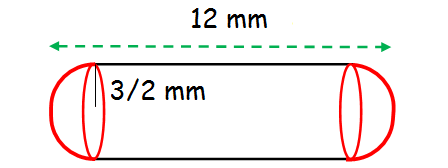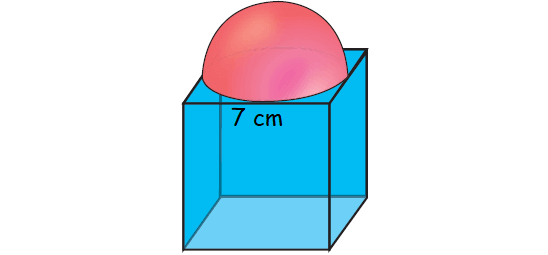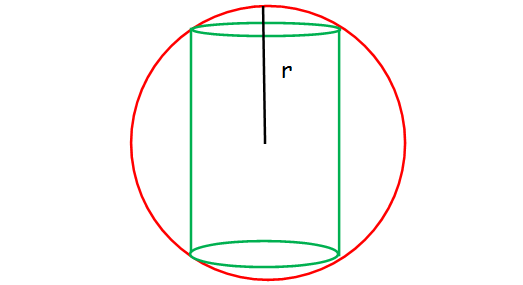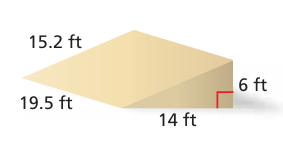SURFACE AREA AND VOLUME OF COMBINATION OF SOLIDS QUESTIONS
Subscribe to our ▶️ YouTube channel 🔴 for the latest videos, updates, and tips.
Question 1 :
A capsule is in the shape of a cylinder with two hemisphere stuck to each of its ends. If the length of the entire capsule is 12 mm and the diameter of the capsule is 3 mm, how much medicine it can hold?
Solution :

Capacity of capsule
= 2 Volume of hemisphere + volume of cylinder
= 2(2/3) πr3 + πr2h
= (4/3) πr3 + πr2h
Height of Capsule
= 2 (radius of hemisphere) + height of cylinder
2(3/2) + h = 12
3 + h = 12
h = 12 - 3 = 9
= πr2 [(4/3) r + h]
= (22/7) (3/2)2[(4/3)(3/2) + 9]
= (22/7) (9/4)[2 + 9]
= (11/7) (9/2)(11)
= 77.78 cm3
Question 2 :
As shown in figure a cubical block of side 7 cm is surmounted by a hemisphere. Find the surface area of the solid.
Solution :

Surface area of solid
= surface area of cube + curved surface area of hemisphere - area of base of hemisphere
= 6a2 + 2πr2 - πr2
= 6a2 + πr2
= 6(7)2 + (22/7) (7/2)2
= 294 + 38.5
= 332.5 cm2
Question 3 :
A right circular cylinder just enclose a sphere of radius r units. Calculate (i) the surface area of the sphere (ii) the curved surface area of the cylinder (iii) the ratio of the areas obtained in (i) and (ii).
Solution :

radius of sphere = height of cylinder/2
(i) the surface area of the sphere = 4πr2
(ii) the curved surface area of the cylinder
= 2π r h
= 2π r(2r)
= 4πr2
(iii) the ratio of the areas obtained in (i) and (ii).
= 4πr2 : 4πr2
= 1 : 1
Question 4 :
A shuttle cock used for playing badminton has the shape of a frustum of a cone is mounted on a hemisphere. The diameters of the frustum are 5 cm and 2 cm. The height of the entire shuttle cock is 7 cm. Find its external surface area.
Solution :
Surface area of shuttle cock = curved surface area of frustum cone + curved surface area of hemisphere
= π (R + r) l + 2πr2 ----(1)
Height of shuttle cock = 7
radius of hemisphere + height of frustum cone = 7
1 + h = 7
h = 6
l = √(h2 + (R - r)2)
l = √(62 + ((5/2) - 1)2)
l = √(36 + (9/4)
l = √153/2
l = 12.36/2
l = 6.18
By applying the value of l in (1), we get
= π ((5/2) + 1) l + 2πr2
= π[(7/2)(6.18) + 2 (1)2]
= (22/7)[(21.63 + 2]
= 74.26 cm2
Question 5 :
A quart of paint covers 80 square feet. How many quarts should you buy to paint the ramp with two coats? (Assume you will not paint the bottom of the ramp.)

Solution :
1 quart = 80 square feet
In triangular base,
base = 6 ft, height = 14 ft and height of prism = 19.5 ft
Surface area of prism = 2 area of rectangle + area of base rectangle + 2 x area of triangle
Area of rectangle left and right = 19.5 x 15.2
= 296.4 square ft
Area of rectangle at bottom = 15.2 x 6
= 91.2 square ft
Area of triangular faces = 2 x (1/2) x 14 x 6
= 84 square ft
Required area = 296.4 + 91.2 + 84
= 471.6 square feet
Number of quarts required = 471.6/80
= 5.895
Approximately 6 quarts is needed.
Question 6 :
A cone with radius 3 ft and height 10 ft has a volume of 30π. What is the volume of the cone formed when the following happens to the original cone?
a. The radius is doubled.
b. The height is doubled.
c. The radius and the height are both doubled.
Solution :
Volume of given cone = 30π
a) Given radius = 3 ft, when it is doubled then the new radius = 6 ft
Volume of new cone = (1/3) πr2 h
= (1/3) x π x 62 x 10
= 120π cubic ft
New volume becomes 4 times of old.
b) Given height = 10 ft, when it is doubled, then the new height = 20 ft
Volume of new cone = (1/3) πr2 h
= (1/3) x π x 32 x 20
= 60π cubic ft
New volume will become two times of old.
c) New radius = 6 ft, new height = 20 ft
Volume of new cone = (1/3) πr2 h
= (1/3) x π x 62 x 20
= 240π cubic ft
New volume becomes 8 times of old.
Question 7 :
Builders use a plumb bob to find a vertical line. The plumb bob shown at the right combines a regular hexagonal prism with a pyramid. Find its volume to the nearest cubic centimeter.

Solution :
In a hexagon, we can create 6 equilateral triangles.
Area of equilateral triangle = (√3/4) a2
Here a = 2 cm
Area of hexagon = 6 (√3/4) ⋅ 22
base area = 6√3 square cm
Volume of hexagonal prism = base area x height
= 6√3 ⋅ 6
= 36√3 cm3
Volume of bottom hexagonal base prism = 6√3 ⋅ 3
= 18√3 cm3
Total volume = (36√3 + 18√3) cm3
= 54√3 cm3
Subscribe to our ▶️ YouTube channel 🔴 for the latest videos, updates, and tips.
Kindly mail your feedback to v4formath@gmail.com
We always appreciate your feedback.
About Us | Contact Us | Privacy Policy
©All rights reserved. onlinemath4all.com

Recent Articles
-
10 Hard SAT Math Questions (Part - 44)
Jan 12, 26 06:35 AM
10 Hard SAT Math Questions (Part - 44) -
US Common Core K-12 Curricum Algebra Solving Simple Equations
Jan 07, 26 01:53 PM
US Common Core K-12 Curricum Algebra Solving Simple Equations -
10 Hard SAT Math Questions (Part - 4)
Jan 05, 26 06:56 PM
10 Hard SAT Math Questions (Part - 4)
